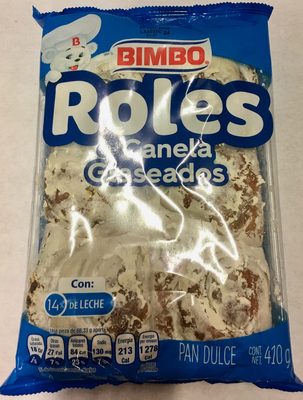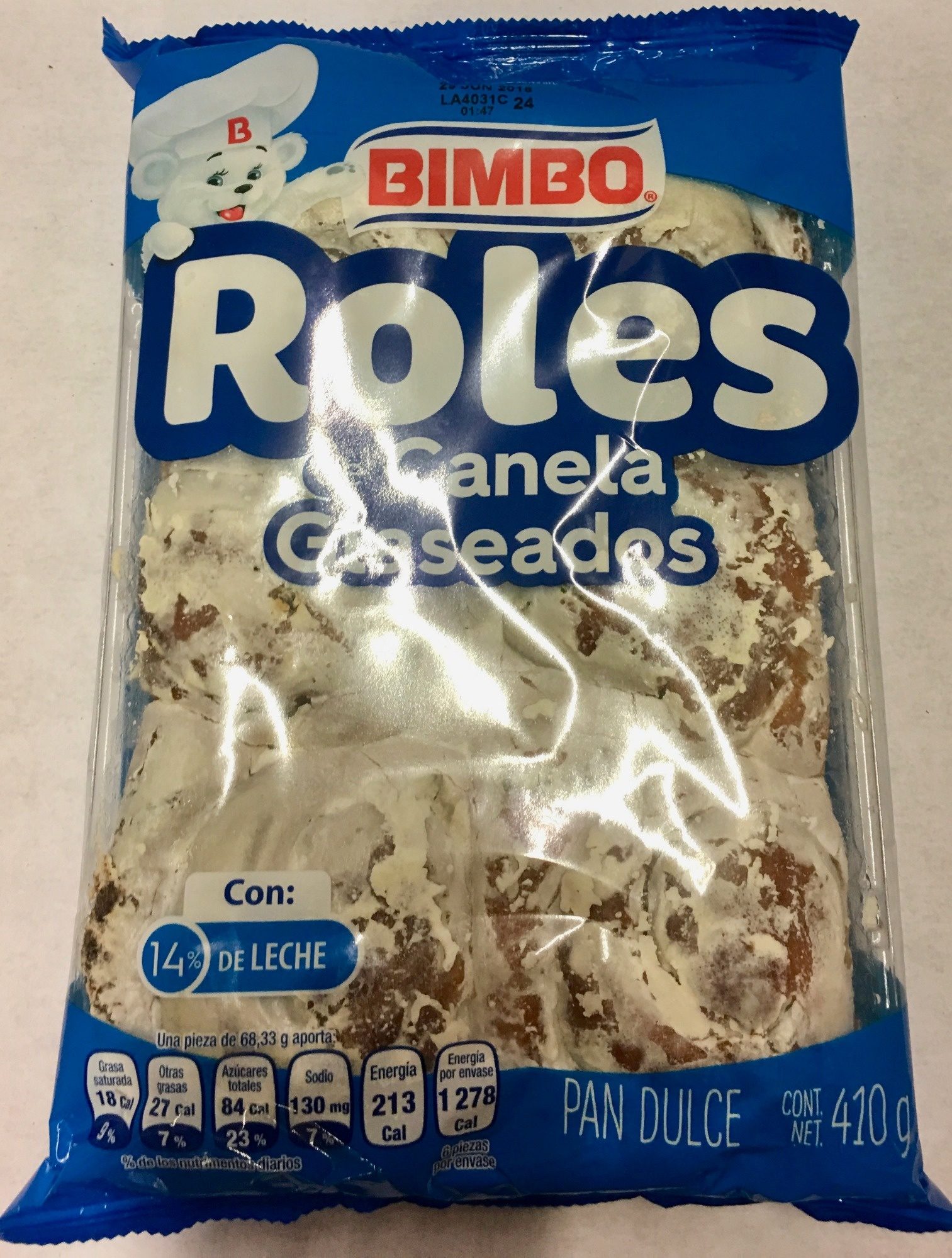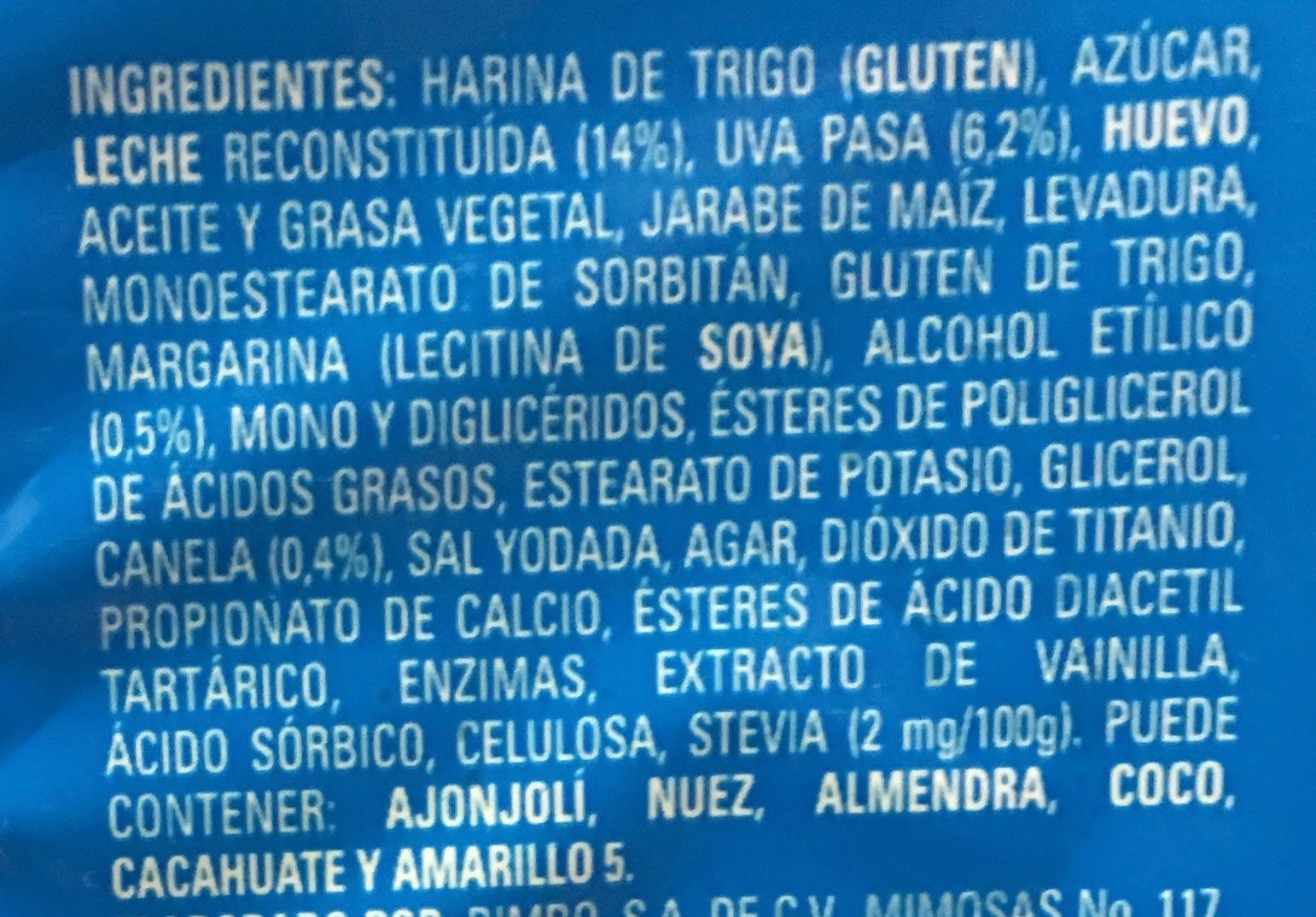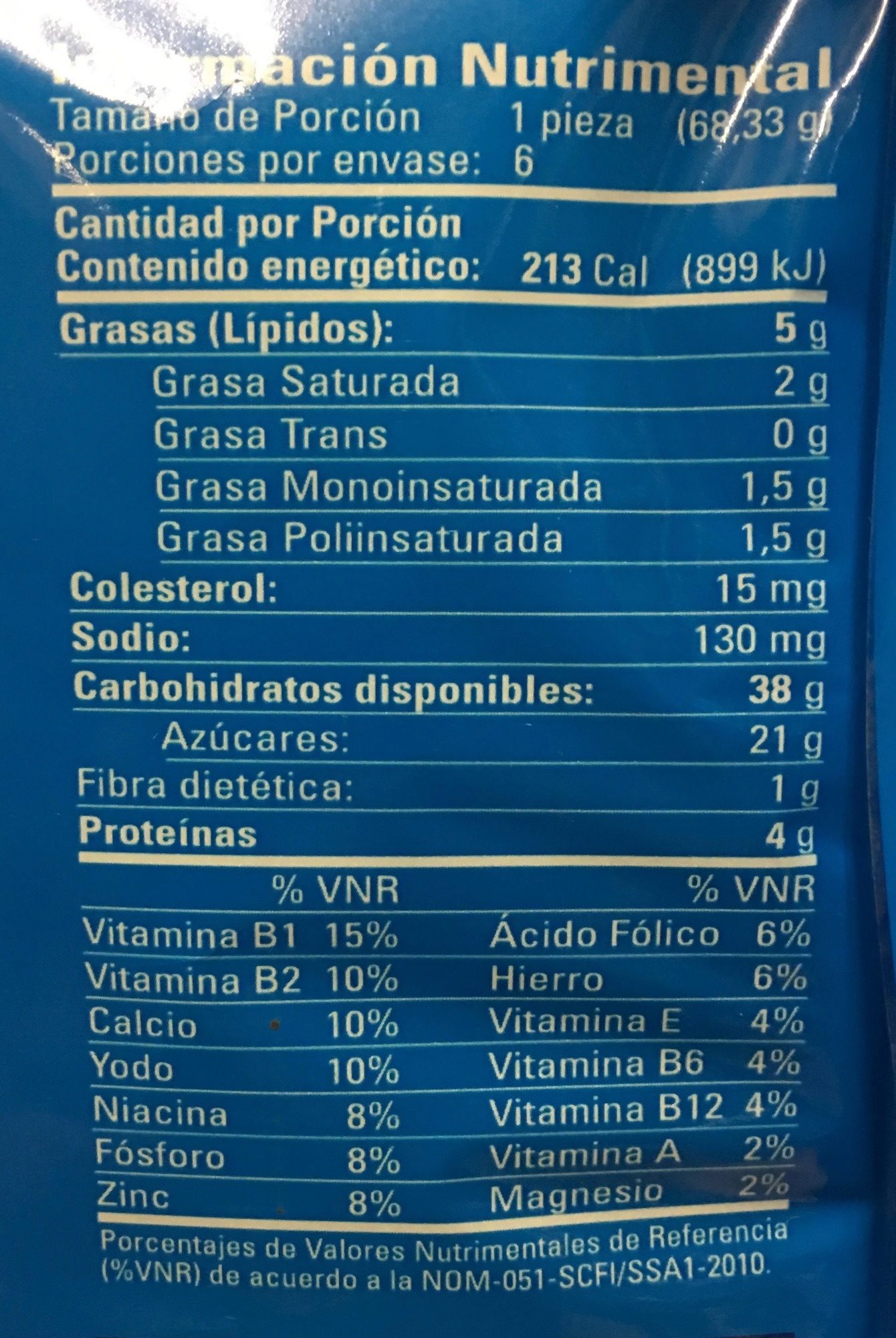Help us make food transparency the norm!
As a non-profit organization, we depend on your donations to continue informing consumers around the world about what they eat.
The food revolution starts with you!
ROLES de Canela Glaseados - BIMBO - 410 g
ROLES de Canela Glaseados - BIMBO - 410 g
This product page is not complete. You can help to complete it by editing it and adding more data from the photos we have, or by taking more photos using the app for Android or iPhone/iPad. Thank you!
×
Barcode: 7501000316878 (EAN / EAN-13)
Common name: PANES DE CANELA GLASEADOS
Quantity: 410 g
Packaging: es:BOLSA DE PLÁSTICO
Brands: BIMBO
Categories: Plant-based foods and beverages, Plant-based foods, Snacks, Cereals and potatoes, Sweet snacks, Confectioneries, Breads, Candies, es:PAN DULCE GLASEADO
Labels, certifications, awards: es:EMPAQUE DEGRADABLE
Origin of ingredients: es:CIUDAD DE MÉXICO
Manufacturing or processing places: CIUDAD DE MÉXICO
Traceability code: BM-92881-01-K17
Link to the product page on the official site of the producer: https://www.bimbo.com.mx/es
Stores: OXXO, KIOSKO, BODEGA AURRERÁ, WALMART, SUPERAMA, LA COMERCIAL, CHEDRAUI, MERCADO SORIANA, SORIANA
Countries where sold: Mexico
Matching with your preferences
Health
Ingredients
-
29 ingredients
Spanish: HARINA DE TRIGO (GLUTEN), AZÚCAR, LECHE RECONSTITUIDA (14%). UVA PASA (6,2%) HUEVO, ACEITE Y GRASA VEGETAL, JARABE DE MAÍZ, LEVADURA, MONOESTEARATO DE SORBITÁN, GLUTEN DE TRIGO MARGARINA (LECITINA DE SOYA), ALCOHOL ETÍLICO (0,5%), MONO Y DIGLICERIDOS, ESTERES DE POLIGLICEROL DE ACIDOS GRASOS, ESTEARATO DE POTASIO, GLICEROL CANELA (0,4%), SAL YODADA, AGAR, DIÓXIDO DE TITANIO. PROPIONATO DE CALCIO, ESTERES DE ÁCIDO DIACETL TARTÁRICO, ENZIMAS, EXTRACTO DE VAINILLA, ÁCIDO SÓRBICO, CELULOSA, STEVIA (2 mg/100g). PUEDE CONTENER: AJONJOLÍ, NUEZ, ALMENDRA, COCO, CACAHUATE Y AMARILLO 5.Allergens: Eggs, Gluten, Milk, Nuts, Peanuts, Sesame seeds, Soybeans, es:amarillo-5, es:cocoTraces: Eggs, Gluten, Nuts, Peanuts, Sesame seeds
Food processing
-
Ultra processed foods
Elements that indicate the product is in the 4 - Ultra processed food and drink products group:
- Additive: E171 - Titanium dioxide
- Additive: E322 - Lecithins
- Additive: E406 - Agar
- Additive: E422 - Glycerol
- Additive: E460 - Cellulose
- Additive: E960 - Steviol glycosides
Food products are classified into 4 groups according to their degree of processing:
- Unprocessed or minimally processed foods
- Processed culinary ingredients
- Processed foods
- Ultra processed foods
The determination of the group is based on the category of the product and on the ingredients it contains.
Additives
-
E1510 - Ethanol
Ethanol: Ethanol, also called alcohol, ethyl alcohol, grain alcohol, and drinking alcohol, is a chemical compound, a simple alcohol with the chemical formula C2H5OH. Its formula can be also written as CH3−CH2−OH or C2H5−OH -an ethyl group linked to a hydroxyl group-, and is often abbreviated as EtOH. Ethanol is a volatile, flammable, colorless liquid with a slight characteristic odor. It is a psychoactive substance and is the principal type of alcohol found in alcoholic drinks. Ethanol is naturally produced by the fermentation of sugars by yeasts or via petrochemical processes, and is most commonly consumed as a popular recreational drug. It also has medical applications as an antiseptic and disinfectant. The compound is widely used as a chemical solvent, either for scientific chemical testing or in synthesis of other organic compounds, and is a vital substance used across many different kinds of manufacturing industries. Ethanol is also used as a clean-burning fuel source.Source: Wikipedia
-
E171 - Titanium dioxide
Titanium dioxide: Titanium dioxide, also known as titaniumIV oxide or titania, is the naturally occurring oxide of titanium, chemical formula TiO2. When used as a pigment, it is called titanium white, Pigment White 6 -PW6-, or CI 77891. Generally, it is sourced from ilmenite, rutile and anatase. It has a wide range of applications, including paint, sunscreen and food coloring. When used as a food coloring, it has E number E171. World production in 2014 exceeded 9 million metric tons. It has been estimated that titanium dioxide is used in two-thirds of all pigments, and the oxide has been valued at $13.2 billion.Source: Wikipedia
-
E200 - Sorbic acid
Sorbic acid: Sorbic acid, or 2‚4-hexadienoic acid, is a natural organic compound used as a food preservative. It has the chemical formula CH3-CH-4CO2H. It is a colourless solid that is slightly soluble in water and sublimes readily. It was first isolated from the unripe berries of the Sorbus aucuparia -rowan tree-, hence its name.Source: Wikipedia
-
E282 - Calcium propionate
Calcium propanoate: Calcium propanoate or calcium propionate has the formula Ca-C2H5COO-2. It is the calcium salt of propanoic acid.Source: Wikipedia
-
E322 - Lecithins
Lecithins are natural compounds commonly used in the food industry as emulsifiers and stabilizers.
Extracted from sources like soybeans and eggs, lecithins consist of phospholipids that enhance the mixing of oil and water, ensuring smooth textures in various products like chocolates, dressings, and baked goods.
They do not present any known health risks.
-
E322i - Lecithin
Lecithins are natural compounds commonly used in the food industry as emulsifiers and stabilizers.
Extracted from sources like soybeans and eggs, lecithins consist of phospholipids that enhance the mixing of oil and water, ensuring smooth textures in various products like chocolates, dressings, and baked goods.
They do not present any known health risks.
-
E406 - Agar
Agar: Agar -pronounced , sometimes - or agar-agar is a jelly-like substance, obtained from red algae.Agar is a mixture of two components: the linear polysaccharide agarose, and a heterogeneous mixture of smaller molecules called agaropectin. It forms the supporting structure in the cell walls of certain species of algae, and is released on boiling. These algae are known as agarophytes, and belong to the Rhodophyta -red algae- phylum.Agar has been used as an ingredient in desserts throughout Asia, and also as a solid substrate to contain culture media for microbiological work. Agar can be used as a laxative, an appetite suppressant, a vegetarian substitute for gelatin, a thickener for soups, in fruit preserves, ice cream, and other desserts, as a clarifying agent in brewing, and for sizing paper and fabrics.The gelling agent in agar is an unbranched polysaccharide obtained from the cell walls of some species of red algae, primarily from tengusa -Gelidiaceae- and ogonori -Gracilaria-. For commercial purposes, it is derived primarily from ogonori. In chemical terms, agar is a polymer made up of subunits of the sugar galactose.Source: Wikipedia
-
E422 - Glycerol
Glycerol: Glycerol -; also called glycerine or glycerin; see spelling differences- is a simple polyol compound. It is a colorless, odorless, viscous liquid that is sweet-tasting and non-toxic. The glycerol backbone is found in all lipids known as triglycerides. It is widely used in the food industry as a sweetener and humectant and in pharmaceutical formulations. Glycerol has three hydroxyl groups that are responsible for its solubility in water and its hygroscopic nature.Source: Wikipedia
-
E460 - Cellulose
Cellulose: Cellulose is an organic compound with the formula -C6H10O5-n, a polysaccharide consisting of a linear chain of several hundred to many thousands of β-1→4- linked D-glucose units. Cellulose is an important structural component of the primary cell wall of green plants, many forms of algae and the oomycetes. Some species of bacteria secrete it to form biofilms. Cellulose is the most abundant organic polymer on Earth. The cellulose content of cotton fiber is 90%, that of wood is 40–50%, and that of dried hemp is approximately 57%.Cellulose is mainly used to produce paperboard and paper. Smaller quantities are converted into a wide variety of derivative products such as cellophane and rayon. Conversion of cellulose from energy crops into biofuels such as cellulosic ethanol is under development as a renewable fuel source. Cellulose for industrial use is mainly obtained from wood pulp and cotton.Some animals, particularly ruminants and termites, can digest cellulose with the help of symbiotic micro-organisms that live in their guts, such as Trichonympha. In human nutrition, cellulose is a non-digestible constituent of insoluble dietary fiber, acting as a hydrophilic bulking agent for feces and potentially aiding in defecation.Source: Wikipedia
-
E960 - Steviol glycosides
Steviol glycoside: Steviol glycosides are the chemical compounds responsible for the sweet taste of the leaves of the South American plant Stevia rebaudiana -Asteraceae- and the main ingredients -or precursors- of many sweeteners marketed under the generic name stevia and several trade names. They also occur in the related species Stevia phlebophylla -but in no other species of Stevia- and in the plant Rubus chingii -Rosaceae-.Steviol glycosides from Stevia rebaudiana have been reported to be between 30 and 320 times sweeter than sucrose, although there is some disagreement in the technical literature about these numbers. They are heat-stable, pH-stable, and do not ferment. Additionally, they do not induce a glycemic response when ingested, because humans can not metabolize stevia. This makes them attractive as natural sugar substitutes for diabetics and other people on carbohydrate-controlled diets. Steviol glycosides stimulate the insulin secretion through potentiation of the β-cell, preventing high blood glucose after a meal. The acceptable daily intake -ADI- for steviol glycosides, expressed as steviol equivalents, has been established to be 4 mg/kg body weight/day, and is based on no observed effects of a 100 fold higher dose in a rat study.Source: Wikipedia
Ingredients analysis
-
May contain palm oil
Ingredients that may contain palm oil: Vegetable oil and fat
-
Non-vegan
Non-vegan ingredients: Milk, EggSome ingredients could not be recognized.
We need your help!
You can help us recognize more ingredients and better analyze the list of ingredients for this product and others:
- Edit this product page to correct spelling mistakes in the ingredients list, and/or to remove ingredients in other languages and sentences that are not related to the ingredients.
- Add new entries, synonyms or translations to our multilingual lists of ingredients, ingredient processing methods, and labels.
If you would like to help, join the #ingredients channel on our Slack discussion space and/or learn about ingredients analysis on our wiki. Thank you!
-
Vegetarian status unknown
Unrecognized ingredients: es:monoestearato-de-sorbitan, es:gluten-de-trigo-margarina, es:mono-y-digliceridos, es:esteres-de-poliglicerol-de-acidos-grasos, es:estearato-de-potasio, es:glicerol-canela, es:esteres-de-acido-diacetl-tartaricoSome ingredients could not be recognized.
We need your help!
You can help us recognize more ingredients and better analyze the list of ingredients for this product and others:
- Edit this product page to correct spelling mistakes in the ingredients list, and/or to remove ingredients in other languages and sentences that are not related to the ingredients.
- Add new entries, synonyms or translations to our multilingual lists of ingredients, ingredient processing methods, and labels.
If you would like to help, join the #ingredients channel on our Slack discussion space and/or learn about ingredients analysis on our wiki. Thank you!
-
Details of the analysis of the ingredients
We need your help!
Some ingredients could not be recognized.
We need your help!
You can help us recognize more ingredients and better analyze the list of ingredients for this product and others:
- Edit this product page to correct spelling mistakes in the ingredients list, and/or to remove ingredients in other languages and sentences that are not related to the ingredients.
- Add new entries, synonyms or translations to our multilingual lists of ingredients, ingredient processing methods, and labels.
If you would like to help, join the #ingredients channel on our Slack discussion space and/or learn about ingredients analysis on our wiki. Thank you!
es: HARINA DE TRIGO, AZÚCAR, LECHE 14%, UVA PASA 6.2%, HUEVO, ACEITE y GRASA VEGETAL, JARABE DE MAÍZ, LEVADURA, MONOESTEARATO DE SORBITÁN, GLUTEN DE TRIGO MARGARINA (LECITINA DE SOYA), ALCOHOL ETÍLICO 0.5%, mono- y DIGLICERIDOS, ESTERES DE POLIGLICEROL DE ACIDOS GRASOS, ESTEARATO DE POTASIO, GLICEROL CANELA 0.4%, SAL YODADA, AGAR, DIÓXIDO DE TITANIO, PROPIONATO DE CALCIO, ESTERES DE ÁCIDO DIACETL TARTÁRICO, ENZIMAS, EXTRACTO DE VAINILLA, ÁCIDO SÓRBICO, CELULOSA, STEVIA, COCO, CACAHUATE, AMARILLO 5- HARINA DE TRIGO -> en:wheat-flour - vegan: yes - vegetarian: yes - ciqual_proxy_food_code: 9410 - percent_min: 14 - percent_max: 60.7
- AZÚCAR -> en:sugar - vegan: yes - vegetarian: yes - ciqual_proxy_food_code: 31016 - percent_min: 14 - percent_max: 28.5
- LECHE -> en:milk - vegan: no - vegetarian: yes - ciqual_proxy_food_code: 19051 - percent_min: 14 - percent: 14 - percent_max: 14
- UVA PASA -> en:raisin - vegan: yes - vegetarian: yes - ciqual_food_code: 13046 - percent_min: 6.2 - percent: 6.2 - percent_max: 6.2
- HUEVO -> en:egg - vegan: no - vegetarian: yes - ciqual_food_code: 22000 - percent_min: 0.5 - percent_max: 6.2
- ACEITE y GRASA VEGETAL -> en:vegetable-oil-and-fat - vegan: yes - vegetarian: yes - from_palm_oil: maybe - percent_min: 0.5 - percent_max: 6.2
- JARABE DE MAÍZ -> en:corn-syrup - vegan: yes - vegetarian: yes - ciqual_proxy_food_code: 31089 - percent_min: 0.5 - percent_max: 6.2
- LEVADURA -> en:yeast - vegan: yes - vegetarian: yes - ciqual_proxy_food_code: 11009 - percent_min: 0.5 - percent_max: 6.2
- MONOESTEARATO DE SORBITÁN -> es:monoestearato-de-sorbitan - percent_min: 0.5 - percent_max: 6.2
- GLUTEN DE TRIGO MARGARINA -> es:gluten-de-trigo-margarina - percent_min: 0.5 - percent_max: 6.2
- LECITINA DE SOYA -> en:soya-lecithin - vegan: yes - vegetarian: yes - ciqual_food_code: 42200 - percent_min: 0.5 - percent_max: 6.2
- ALCOHOL ETÍLICO -> en:e1510 - vegan: yes - vegetarian: yes - percent_min: 0.5 - percent: 0.5 - percent_max: 0.5
- mono- y DIGLICERIDOS -> es:mono-y-digliceridos - percent_min: 0.4 - percent_max: 0.5
- ESTERES DE POLIGLICEROL DE ACIDOS GRASOS -> es:esteres-de-poliglicerol-de-acidos-grasos - percent_min: 0.4 - percent_max: 0.5
- ESTEARATO DE POTASIO -> es:estearato-de-potasio - percent_min: 0.4 - percent_max: 0.5
- GLICEROL CANELA -> es:glicerol-canela - percent_min: 0.4 - percent: 0.4 - percent_max: 0.4
- SAL YODADA -> en:iodised-salt - vegan: yes - vegetarian: yes - ciqual_food_code: 11058 - percent_min: 0 - percent_max: 0.18
- AGAR -> en:e406 - vegan: yes - vegetarian: yes - ciqual_food_code: 11084 - percent_min: 0 - percent_max: 0.18
- DIÓXIDO DE TITANIO -> en:e171 - vegan: yes - vegetarian: yes - percent_min: 0 - percent_max: 0.18
- PROPIONATO DE CALCIO -> en:e282 - vegan: yes - vegetarian: yes - percent_min: 0 - percent_max: 0.18
- ESTERES DE ÁCIDO DIACETL TARTÁRICO -> es:esteres-de-acido-diacetl-tartarico - percent_min: 0 - percent_max: 0.18
- ENZIMAS -> en:enzyme - vegan: maybe - vegetarian: maybe - percent_min: 0 - percent_max: 0.18
- EXTRACTO DE VAINILLA -> en:vanilla-extract - vegan: yes - vegetarian: yes - ciqual_food_code: 11065 - percent_min: 0 - percent_max: 0.18
- ÁCIDO SÓRBICO -> en:e200 - vegan: yes - vegetarian: yes - percent_min: 0 - percent_max: 0.18
- CELULOSA -> en:e460 - vegan: yes - vegetarian: yes - percent_min: 0 - percent_max: 0.18
- STEVIA -> en:e960 - vegan: yes - vegetarian: yes - percent_min: 0 - percent_max: 0.18
- COCO -> en:coconut - vegan: yes - vegetarian: yes - ciqual_proxy_food_code: 15006 - percent_min: 0 - percent_max: 0.18
- CACAHUATE -> en:peanut - vegan: yes - vegetarian: yes - ciqual_food_code: 15001 - percent_min: 0 - percent_max: 0.18
- AMARILLO 5 -> en:e102 - vegan: yes - vegetarian: yes - percent_min: 0 - percent_max: 0.18
Nutrition
-
Average nutritional quality
⚠ ️Warning: the amount of fruits, vegetables and nuts is not specified on the label, it was estimated from the list of ingredients: 6This product is not considered a beverage for the calculation of the Nutri-Score.
Positive points: 4
- Proteins: 3 / 5 (value: 6, rounded value: 6)
- Fiber: 1 / 5 (value: 1, rounded value: 1)
- Fruits, vegetables, nuts, and colza/walnut/olive oils: 0 / 5 (value: 6.2, rounded value: 6.2)
Negative points: 10
- Energy: 2 / 10 (value: 899, rounded value: 899)
- Sugars: 6 / 10 (value: 28.5, rounded value: 28.5)
- Saturated fat: 2 / 10 (value: 3, rounded value: 3)
- Sodium: 0 / 10 (value: 72, rounded value: 72)
The points for proteins are counted because the negative points are less than 11.
Nutritional score: (10 - 4)
Nutri-Score:
-
Nutrient levels
-
Fat in moderate quantity (7.5%)
What you need to know- A high consumption of fat, especially saturated fats, can raise cholesterol, which increases the risk of heart diseases.
Recommendation: Limit the consumption of fat and saturated fat- Choose products with lower fat and saturated fat content.
-
Saturated fat in moderate quantity (3%)
What you need to know- A high consumption of fat, especially saturated fats, can raise cholesterol, which increases the risk of heart diseases.
Recommendation: Limit the consumption of fat and saturated fat- Choose products with lower fat and saturated fat content.
-
Sugars in high quantity (28.5%)
What you need to know- A high consumption of sugar can cause weight gain and tooth decay. It also augments the risk of type 2 diabetes and cardio-vascular diseases.
Recommendation: Limit the consumption of sugar and sugary drinks- Sugary drinks (such as sodas, fruit beverages, and fruit juices and nectars) should be limited as much as possible (no more than 1 glass a day).
- Choose products with lower sugar content and reduce the consumption of products with added sugars.
-
Salt in low quantity (0.18%)
What you need to know- A high consumption of salt (or sodium) can cause raised blood pressure, which can increase the risk of heart disease and stroke.
- Many people who have high blood pressure do not know it, as there are often no symptoms.
- Most people consume too much salt (on average 9 to 12 grams per day), around twice the recommended maximum level of intake.
Recommendation: Limit the consumption of salt and salted food- Reduce the quantity of salt used when cooking, and don't salt again at the table.
- Limit the consumption of salty snacks and choose products with lower salt content.
-
-
Nutrition facts
Nutrition facts As sold
for 100 g / 100 mlAs sold
per serving (68.33 g)Compared to: Candies Energy 899 kj
(315 kcal)614 kj
(215 kcal)-39% Fat 7.5 g 5.12 g +339% Saturated fat 3 g 2.05 g +207% Monounsaturated fat 1.5 g 1.02 g +15% Polyunsaturated fat 1.5 g 1.02 g +244% Trans fat 0 g 0 g Cholesterol 15 mg 10.2 mg +2,046% Carbohydrates 57 g 38.9 g -31% Sugars 28.5 g 19.5 g -49% Fiber 1 g 0.683 g +87% Proteins 6 g 4.1 g +190% Salt 0.18 g 0.123 g +42% Alcohol 0.5 % vol 0.5 % vol Vitamin A 30 µg (2 % DV) 20.5 µg +1,171% Vitamin E 0.8 mg (4 % DV) 0.547 mg -94% Vitamin B1 (Thiamin) 15,000 mg (15 % DV) 10,200 mg +1,315% Vitamin B2 (Riboflavin) 0.17 mg (10 % DV) 0.116 mg -87% Vitamin B3/PP (Niacin) 1.6 mg (8 % DV) 1.09 mg -91% Vitamin B6 (Pyridoxin) 0.08 mg (4 % DV) 0.055 mg -97% Vitamin B9 (Folic acid) 24 µg (6 % DV) 16.4 µg -100% Vitamin B12 (cobalamin) 0.24 µg (4 % DV) 0.164 µg -99% Calcium 100 mg (10 % DV) 68.3 mg +675% Phosphorus 80 mg (8 % DV) 54.7 mg Iron 1.08 mg (6 % DV) 0.738 mg +422% Magnesium 8 mg (2 % DV) 5.47 mg Zinc 1.2 mg (8 % DV) 0.82 mg -93% Iodine 15 µg (10 % DV) 10.2 µg Fruits‚ vegetables‚ nuts and rapeseed‚ walnut and olive oils (estimate from ingredients list analysis) 6.2 % 6.2 %
Environment
-
Eco-Score C - Moderate environmental impact
⚠ ️Select a country in order to include the full impact of transportation.The Eco-Score is an experimental score that summarizes the environmental impacts of food products.→ The Eco-Score was initially developped for France and it is being extended to other European countries. The Eco-Score formula is subject to change as it is regularly improved to make it more precise and better suited to each country.Life cycle analysis
-
Average impact of products of the same category: B (Score: 62/100)
Category: Candies, all types
Category: Candies, all types
- PEF environmental score: 0.41 (the lower the score, the lower the impact)
- including impact on climate change: 1.72 kg CO2 eq/kg of product
Stage Impact Agriculture
78.2 %Processing
10.6 %Packaging
5.5 %Transportation
4.5 %Distribution
1.1 %Consumption
0.0 %
Bonuses and maluses
-
Missing origins of ingredients information
Malus: -5
⚠ ️ The origins of the ingredients of this product are not indicated.
If they are indicated on the packaging, you can modify the product sheet and add them.
If you are the manufacturer of this product, you can send us the information with our free platform for producers.
-
Packaging with a medium impact
Malus: -10
Shape Material Recycling Impact Bag Plastic High
Eco-Score for this product
-
Impact for this product: C (Score: 47/100)
Product: ROLES de Canela Glaseados - BIMBO - 410 g
Life cycle analysis score: 62
Sum of bonuses and maluses: -15
Final score: 47/100
-
Carbon footprint
-
Equal to driving 0.9 km in a petrol car
172 g CO² per 100g of product
The carbon emission figure comes from ADEME's Agribalyse database, for the category: Candies, all types (Source: ADEME Agribalyse Database)
Stage Impact Agriculture
52.2 %Processing
19.5 %Packaging
15.7 %Transportation
11.6 %Distribution
1.0 %Consumption
0.0 %
Packaging
-
Packaging with a medium impact
-
Packaging parts
Bag (Plastic)
-
Packaging materials
Material % Packaging weight Packaging weight per 100 g of product Plastic
-
Transportation
-
Origins of ingredients
Missing origins of ingredients information
⚠ ️ The origins of the ingredients of this product are not indicated.
If they are indicated on the packaging, you can modify the product sheet and add them.
If you are the manufacturer of this product, you can send us the information with our free platform for producers.Add the origins of ingredients for this product Add the origins of ingredients for this product
Report a problem
-
Incomplete or incorrect information?
Category, labels, ingredients, allergens, nutritional information, photos etc.
If the information does not match the information on the packaging, please complete or correct it. Open Food Facts is a collaborative database, and every contribution is useful for all.
Data sources
Product added on by openfoodfactsmx
Last edit of product page on by roboto-app.
Product page also edited by fix-salt-bot, kiliweb, packbot, yuka.VklZclB2MDRuc2t6bGZZNnBqbnZvTUo3KzRPSFRGTHBOdkJLSVE9PQ.











